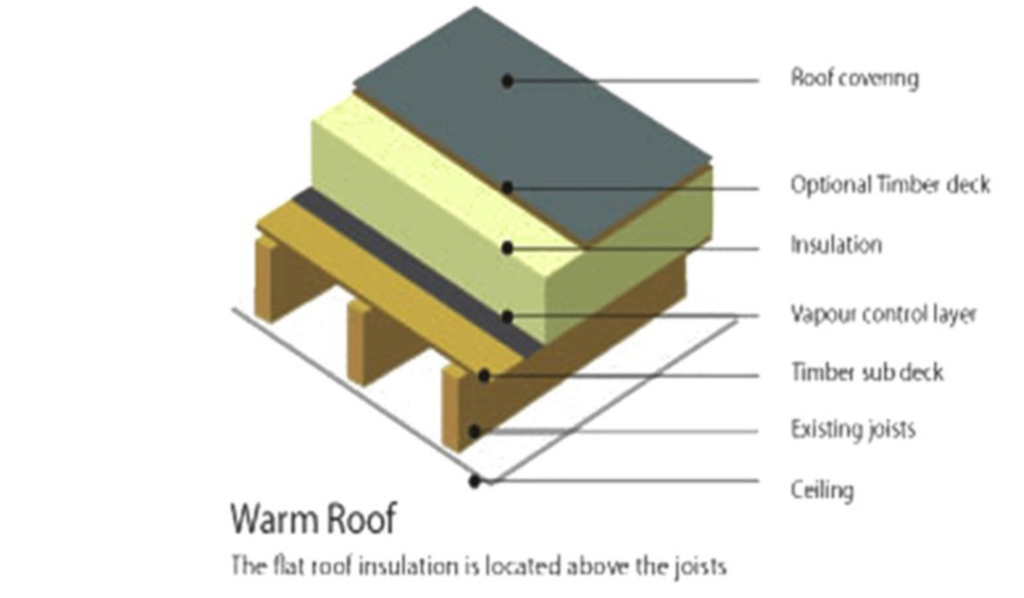We’re all familiar with cold roofs, but what about the opposite? Warm roofs? If you want to understand what is a warm roof, as well as the benefits of a warm roof, this article is for you.
A warm roof is an insulation system for roofs that minimises heat loss and improves energy efficiency. It does this by keeping the heat in the building during winter and making the building cooler in summer. There are two types of warm roofs: internal and external.
Internal warm roofs are more common in new build developments as they are easier to install. External warm roofs are more suited to refurbishments as they can be retrofitted without needing to strip the existing roof covering.
Are you considering a warm roof for your next building project? If so, you’re not alone. Many architects and builders are now specifying warm roofs as the preferred option for new construction.
What is a Warm Roof?
A warm roof is simply one where the insulation is placed above the waterproofing layer, rather than below it. This has several advantages, including improved energy efficiency and reduced condensation risk.
Warm roofs also tend to be lighter in weight than traditional “cold” roofs, which can simplify the construction process. There are some potential drawbacks to warm roofs as well, however. One is that they can be more expensive to install than cold roofs.
Another is that if not properly designed and ventilated, they can lead to trapped heat and moisture build-up within the insulation layer – which can eventually lead to problems like mold growth or rot. Overall, though, warm roofs are an increasingly popular choice for new buildings – thanks to their many benefits. So if you’re thinking about going with a warm roof for your next project, rest assured that you’re making a sound decision.
What are the Advantages of a Warm Roof?
When it comes to your roof, there are two different types of designs – warm and cold. A warm roof is one where the insulation is placed above the structural deck, while a cold roof has the insulation below the deck. So, what are the advantages of a warm roof?
Let’s take a look… One of the main advantages of a warm roof is that it helps to prevent condensation. This is because the heat from your home rises and escapes through the top of the house, taking any moisture with it.
This means that there’s less chance for condensation to form on your ceiling or in your attic space. Another advantage of a warm roof is that it can help to improve energy efficiency. This is because heat loss through the roof is reduced, meaning you don’t have to use as much energy to heat your home (and so you save money on your energy bills).
Lastly, a warm roof can also extend the life of your roofing materials. This is because they’re not exposed to cold temperatures which can cause them to deteriorate over time. So, if you want your roof to last longer, opt for a warm design!
Is a Warm Roof Better Than a Cold Roof?
A warm roof is one in which the insulation is placed above the structural deck, so that the roof space is kept warmer. A cold roof is one where the insulation is placed below the structural deck, allowing the roof space to be cooler. There are advantages and disadvantages to both types of roofs.
A warm roof will typically have a longer lifespan than a cold roof since the temperature differential between the inside and outside of the building is lessened. The reduced temperature differential also means that there is less condensation within the building, which can lead to mold and mildew growth. However, a warm roof costs more to construct than a cold roof because of the additional insulation required.
A cold roof may not have as long of a lifespan as a warm roof due to the temperature differential between the inside and outside of the building, but it will cost less to construct. The increased temperature differential can lead to condensation within the building, which can then lead to mold and mildew growth.
Conclusion
If you’re considering a warm roof for your home, you might be wondering how effective they actually are. Warm roofs are designed to keep your home warmer in the winter and cooler in the summer, by providing an extra layer of insulation. In most cases, warm roofs are made with a layer of foil that reflects heat back into the house.
Warm roofs can be an effective way to improve the energy efficiency of your home. In fact, they can help you save up to 25% on your heating and cooling costs each year. They’re also relatively easy to install, and don’t require any major changes to your existing roof.
If you’re looking for a way to make your home more comfortable and reduce your energy bills, a warm roof could be a good option for you.

